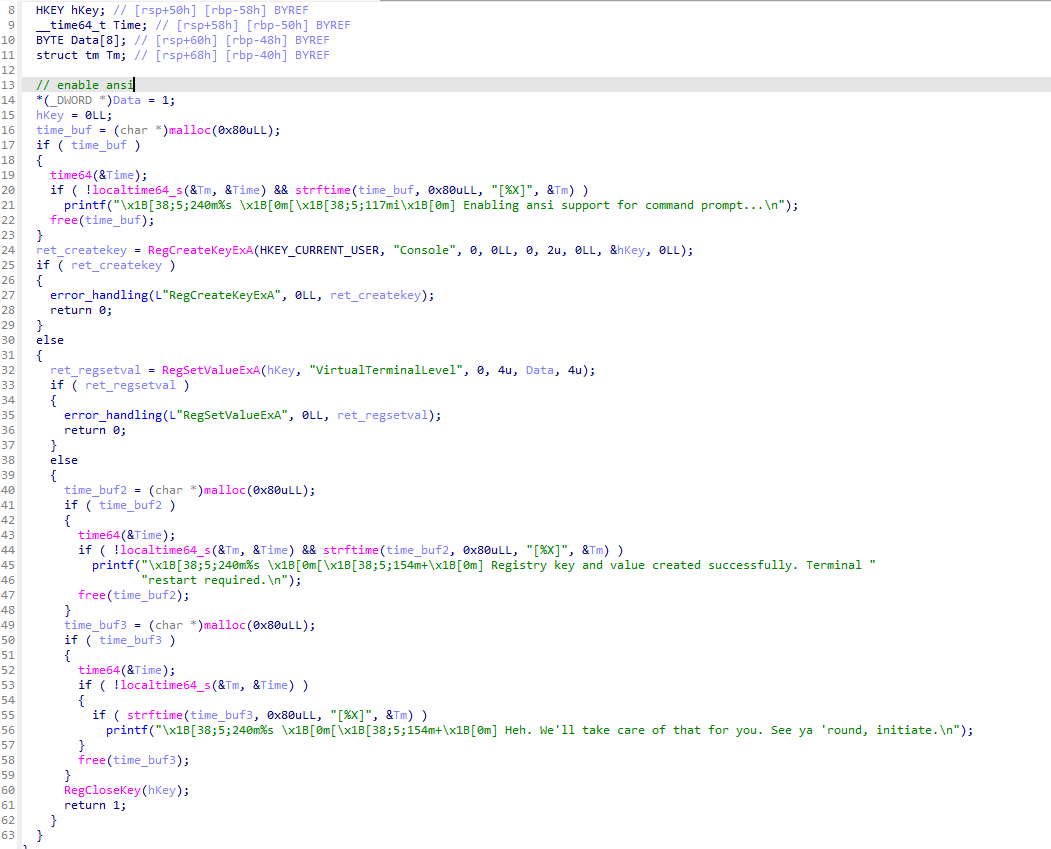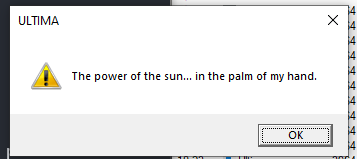Ultima Analysis
Table of Contents
So, ya boi is back with yet another of his geeky interests. This time we are gonna be taking a look at a sample made by crow called “ultima”, it is apparently a easy reversing challenge for new malware analysts like me, so without further a do, lets get started taking this chunk of bytes apart!!
Basic Info and Analysis
To start, let’s throw this sucka into PE-Bear and get some basic info about the sample:
ultima
basic info-----------------------------------------------------------------------
( extracted using pe bear v0.7.0 )
name ultima.exe.crow
md5 73c0bd614ceeaa765f9e1284c28fdc16
sha256 f48f43594cc5563217a6a19d2af2dc8d82f397a98540fd96c0c5b7d6d6a2a402
type pe (exe)
file size 30840
creation 28.02.2024 09:18:2024 UTC
modified 28.02.2024 10:32:2024 UTC
---------------------------------------------------------------------------------
Now because I was lucky once a few months ago, I check the headers for anything unusual, like a modified DOS stub or something; However I found… exactly nothing. (womp womp) Anyhow let’s proceed, I look for any weird sections or a big difference between the size on disk and size in memory, but we (luckily) find nothing special (see note on why), except that the binary seems to be compiled with debug symbols… rookie mistake haha.
* But DeLuks, why would it be a problem if theres something weird in the sections
Well dear reader, if we were to find something weird, it could be a indicator that the sample is packed, which sucks! (because I got a massive skill issue)
Next let’s go on to the strin- WAIT ITS SIGNED, there is a lot of junk in the strings but we see some digicert stuff and the info about the signature, heres what I found:
signature-------------------------------------------
name Garlean Empire / digicert 2023
email gaius@mysweetchocobo.eo
time 28.02.2024 11:32:24
valid 27.02.2025
----------------------------------------------------
Okay, back to strings, we see more trash and then boom, we stumble across very descriptive strings that give us a good idea of what the sample does:
Attempting to read value from Computer\HKEY_CURRENT_USER\Console\VirtualTerminalLevel...
Computer\HKEY_CURRENT_USER\Console\VirtualTerminalLevel exists but isn't set to one...
Computer\HKEY_CURRENT_USER\Console\VirtualTerminalLevel is already set to one!
Computer\HKEY_CURRENT_USER\Console\VirtualTerminalLevel wasn't found!
Enabling ansi support for command prompt...
Registry key and value created successfully. Terminal restart required.
Heh. We'll take care of that for you. See ya 'round, initiate.
This seems to be checking if ANSI is enabled on the system… weird bit
alright. Then we see a banner and right below we see that it creates a text
file in C:\Temp called garlean_note.txt. No idea why but aight…
Branded by the Garlean Empire.
C:\Temp
C:\Temp\garlean_note.txt
Left a little nugget beh
Right below that we see some strange plaintext strings and below a welcome message with a login prompt, from that we can assume these could be some credentials. Better note these down for later.
gaius
glitterychocobo123
Welcome operator. Use your Empire-issued credentials to sign in.
Username :: >
Password :: >
Then we see some debug prints that are very verbose and describe the samples behaviour extremely well, Awesome!!
[0x%p] Current process handle.
VirtualAlloc
[0x%p] [RW-] Allocated a buffer with PAGE_READWRITE [RW-] permissions!
WriteProcessMemory
[0x%p] [RW-] [%zu/%zu] Writing payload bytes to the allocated buffer...
[0x%p] [RW-] Wrote %zu-bytes to the allocated buffer
VirtualProtect
[0x%p] [R-X] Changed buffer's page protection to PAGE_EXECUTE_READ [R-X]
CreateThread
[0x%p] Thread created! waiting for it to finish its execution...
[0x%p] Thread finished execution, beginning cleanup...
[0x%p] Closed process handle
[0x%p] Closed thread handle
[0x%p] Remote buffer freed
From this we see this could be a local shellcode injection, which also means we’ll maybe have to reverse some shellcode maybe. T-T
SPOILER: We won’t have to do that because *dynamic analysis* O-O
Anywayys we see some more signature junk and finally the location of the pdb file on the malware developers machine:
C:\Users\hepha\Documents\Programs\maldev\Ultima\x64\Release\Ultima.pdb
Now, let’s take a look at the Imports. We first see some stdlib stuff which is
not really malicious, but then we see that it imports some rather interesting
functions from KERNEL32 and ADVAPI32 these, again, indicate that the sample
modifies some registry values (possibly to enable ANSI) and does a (local) process injection.
/*---------[ Registry Modifications ]---------*/
RegGetValueA
RegCreateKeyExA
RegSetValueExA
RegCloseKey
/*---------[ Strong Indicators of a Process Injection ]---------*/
GetCurrentProcessId
GetCurrentThreadId
GetCurrentProcess
WriteProcessMemory
VirtualProtect
VirtualAlloc
CreateThread
Now lets confirm our finds with capa, below you can see the capa output:
ATT&CK Tactic │ ATT&CK Technique
DEFENSE EVASION │ Process Injection::Thread Execution Hijacking T1055.003
│ Reflective Code Loading T1620
DISCOVERY │ Query Registry T1012
EXECUTION │ Shared Modules T1129
MBC Objective │ MBC Behavior
FILE SYSTEM │ Create Directory [C0046]
OPERATING SYSTEM │ Registry::Query Registry Value [C0036.006]
│ Registry::Set Registry Key [C0036.001]
PROCESS │ Create Thread [C0038]
Capability │ Namespace
contains PDB path │ executable/pe/pdb
create directory │ host-interaction/file-system/create
inject thread │ host-interaction/process/inject
query or enumerate registry value │ host-interaction/registry
set registry value │ host-interaction/registry/create
parse PE header │ load-code/pe
Now as we can see I may have been right, however we cannot trust these tools fully so we need to take this sucka apart in IDA.
Static Analysis with IDA
Since ya boi has absolutely ZERO skills, we hit that F5 faster than light can reach it. And now that we see our pseudo-C, we can start reversing this sucka.
The main function first checks if ANSI is enabled, if not it enables it and prompts the “victim” to restart the Program. If it is enabled we proceed to the login where the sample does its magic:

Let’s step into the ANSI check just to be sure its doing what its supposed to…

Aand yeah, looks fine! It reads the Computer\HKEY_CURRENT_USER\Console\VirtualTerminalLevel
and checks if it is set to 1, which obviuosly means that it’s on. If it ain’t on, we return 0,
otherwise a 1 is returned.
Next we gotta check the other function I named “enable_ansi” juuust in case:

Yuup, seems aight. It creates a new key at HKEY_CURRENT_USER\Console called “VirtualTerminalLevel”
and sets its value to 1, how nice :)
On to the fun part, the login function check for specific credentials and gives the user/victim 3 tries before it exits, however, the credentials are stored in plaintext so we can just note those down and proceed.

Now at the end of the login we see a function gets called that, when taking a closer look it does a “local shellcode process injection” (lots of words just to say it injects some shellcode into itself). As you may by know have noticed I’m pretty new at this so ain’t no way in hell im reversing shellcode.

Dynamic Analysis
So, let’s run this (in a VM!!) and see what happens B)

Taking a look at procmon, theres a loooot of stuff but everything is as expected. And as a payload we get this cute little MessageBox:

To sum up program checks for ansi support, enables ansi if necessary, throws a little
login prompt and finally injects into itself a little message box and leaves a file in
C:\Temp\
Conclusion
Cool, mystery solved. Here is a little graph for ya to get the gist of how this thingy works:

Thats all folks! Hope yall enjoyed it! Now I know this post consists of more pictures than quality content however keep a look out for the next post, which will be all about reversing a proper malware sample and not a gameified little program.
Be sure to check out crow and his YouTube channel and I’ll catch ya later!!
Extra Little Section
To: MalwareAuthor@mycodesucks.org
Dear Threat-actor,
PLEASE do better next time, will ya?
- use prints in debug builds
- and don’t release your darn sample compiled with debug symbols
- maybe even consider doing API hashing to hide those imports
Love, DeLuks <3